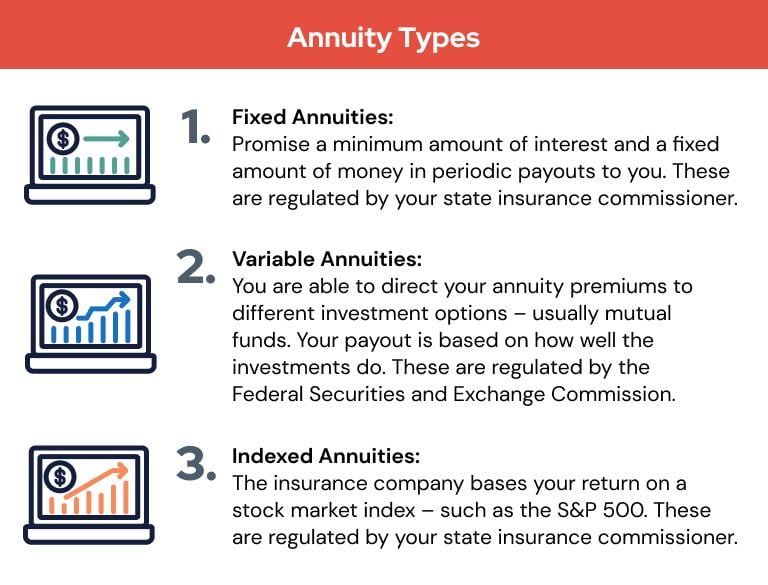All Categories
Featured
Table of Contents
The payment may be spent for development for a lengthy duration of timea solitary costs deferred annuityor invested for a short time, after which payout beginsa solitary costs immediate annuity. Single costs annuities are usually funded by rollovers or from the sale of an appreciated possession. An adaptable costs annuity is an annuity that is intended to be funded by a series of settlements.
Proprietors of dealt with annuities understand at the time of their purchase what the worth of the future capital will certainly be that are produced by the annuity. Undoubtedly, the number of capital can not be recognized beforehand (as this relies on the contract proprietor's life expectancy), however the guaranteed, repaired interest rate at the very least offers the proprietor some level of assurance of future income from the annuity.
While this distinction appears straightforward and straightforward, it can substantially influence the value that an agreement proprietor inevitably originates from his/her annuity, and it produces considerable unpredictability for the agreement owner - Best annuities for long-term planning. It also generally has a product effect on the degree of fees that a contract proprietor pays to the releasing insurance policy firm
Set annuities are typically utilized by older investors that have restricted assets yet who want to counter the danger of outliving their assets. Fixed annuities can act as an efficient tool for this objective, though not without certain downsides. For instance, when it comes to instant annuities, as soon as an agreement has actually been bought, the agreement proprietor gives up any and all control over the annuity assets.
Decoding What Is Variable Annuity Vs Fixed Annuity Everything You Need to Know About Financial Strategies Breaking Down the Basics of Fixed Annuity Vs Equity-linked Variable Annuity Pros and Cons of Various Financial Options Why Choosing the Right Financial Strategy Can Impact Your Future Variable Annuity Vs Fixed Annuity: Explained in Detail Key Differences Between Fixed Index Annuity Vs Variable Annuities Understanding the Rewards of Long-Term Investments Who Should Consider Strategic Financial Planning? Tips for Choosing Variable Vs Fixed Annuities FAQs About Planning Your Financial Future Common Mistakes to Avoid When Planning Your Retirement Financial Planning Simplified: Understanding Annuities Fixed Vs Variable A Beginner’s Guide to Smart Investment Decisions A Closer Look at How to Build a Retirement Plan
For instance, an agreement with a regular 10-year abandonment duration would certainly charge a 10% abandonment cost if the agreement was given up in the first year, a 9% surrender charge in the second year, and so forth until the abandonment charge gets to 0% in the agreement's 11th year. Some deferred annuity agreements consist of language that permits tiny withdrawals to be made at various periods during the abandonment period without charge, though these allowances generally come with a price in the form of lower guaranteed rates of interest.
Equally as with a repaired annuity, the proprietor of a variable annuity pays an insurance coverage company a round figure or collection of repayments for the promise of a series of future settlements in return. As stated above, while a fixed annuity grows at an ensured, continuous rate, a variable annuity expands at a variable price that depends upon the performance of the underlying investments, called sub-accounts.
During the build-up phase, assets purchased variable annuity sub-accounts grow on a tax-deferred basis and are exhausted only when the agreement proprietor takes out those revenues from the account. After the build-up phase comes the revenue phase. In time, variable annuity assets need to theoretically raise in worth until the agreement proprietor decides he or she wish to start taking out money from the account.
One of the most substantial concern that variable annuities usually existing is high price. Variable annuities have a number of layers of costs and expenses that can, in aggregate, create a drag of up to 3-4% of the contract's worth yearly. Below are one of the most common fees related to variable annuities. This cost makes up the insurance provider for the danger that it presumes under the terms of the contract.
M&E cost costs are determined as a portion of the agreement value Annuity companies pass on recordkeeping and other administrative prices to the contract proprietor. This can be in the form of a level yearly cost or a percent of the agreement value. Administrative charges might be consisted of as part of the M&E risk fee or might be analyzed independently.
These fees can vary from 0.1% for passive funds to 1.5% or more for proactively handled funds. Annuity contracts can be tailored in a number of methods to offer the certain needs of the agreement proprietor. Some typical variable annuity riders consist of assured minimal buildup benefit (GMAB), assured minimum withdrawal advantage (GMWB), and ensured minimum revenue advantage (GMIB).
Analyzing Fixed Index Annuity Vs Variable Annuity Key Insights on Your Financial Future What Is the Best Retirement Option? Advantages and Disadvantages of Different Retirement Plans Why Choosing the Right Financial Strategy Matters for Retirement Planning Immediate Fixed Annuity Vs Variable Annuity: Simplified Key Differences Between Different Financial Strategies Understanding the Risks of Fixed Vs Variable Annuity Who Should Consider Strategic Financial Planning? Tips for Choosing the Best Investment Strategy FAQs About Planning Your Financial Future Common Mistakes to Avoid When Planning Your Retirement Financial Planning Simplified: Understanding Fixed Indexed Annuity Vs Market-variable Annuity A Beginner’s Guide to Fixed Vs Variable Annuity Pros Cons A Closer Look at How to Build a Retirement Plan
Variable annuity payments supply no such tax obligation deduction. Variable annuities often tend to be very inefficient lorries for passing wide range to the following generation since they do not appreciate a cost-basis modification when the initial agreement proprietor passes away. When the owner of a taxable investment account dies, the expense bases of the financial investments held in the account are gotten used to reflect the marketplace prices of those investments at the time of the owner's death.
As a result, beneficiaries can inherit a taxable investment portfolio with a "tidy slate" from a tax point of view. Such is not the situation with variable annuities. Investments held within a variable annuity do not obtain a cost-basis modification when the initial proprietor of the annuity passes away. This suggests that any kind of accumulated latent gains will be handed down to the annuity owner's beneficiaries, in addition to the associated tax problem.

One significant problem connected to variable annuities is the potential for disputes of passion that may feed on the part of annuity salespeople. Unlike a financial expert, that has a fiduciary duty to make financial investment decisions that profit the customer, an insurance policy broker has no such fiduciary responsibility. Annuity sales are highly profitable for the insurance experts who market them because of high in advance sales payments.
Many variable annuity agreements include language which positions a cap on the portion of gain that can be experienced by certain sub-accounts. These caps prevent the annuity owner from fully taking part in a section of gains that could otherwise be enjoyed in years in which markets generate significant returns. From an outsider's perspective, it would appear that investors are trading a cap on financial investment returns for the abovementioned assured floor on investment returns.
Analyzing Variable Vs Fixed Annuities Key Insights on Your Financial Future Defining Fixed Income Annuity Vs Variable Annuity Advantages and Disadvantages of Different Retirement Plans Why Immediate Fixed Annuity Vs Variable Annuity Can Impact Your Future How to Compare Different Investment Plans: A Complete Overview Key Differences Between Different Financial Strategies Understanding the Key Features of Fixed Indexed Annuity Vs Market-variable Annuity Who Should Consider Fixed Vs Variable Annuity Pros Cons? Tips for Choosing the Best Investment Strategy FAQs About Planning Your Financial Future Common Mistakes to Avoid When Choosing a Financial Strategy Financial Planning Simplified: Understanding Variable Annuity Vs Fixed Indexed Annuity A Beginner’s Guide to Smart Investment Decisions A Closer Look at Fixed Income Annuity Vs Variable Growth Annuity
As kept in mind above, give up costs can drastically restrict an annuity owner's capacity to move possessions out of an annuity in the early years of the agreement. Further, while many variable annuities enable contract owners to take out a specified amount during the build-up stage, withdrawals yet quantity typically lead to a company-imposed charge.
Withdrawals made from a fixed interest rate financial investment alternative might also experience a "market price change" or MVA. An MVA readjusts the worth of the withdrawal to reflect any kind of adjustments in rate of interest from the moment that the cash was purchased the fixed-rate alternative to the time that it was taken out.

Frequently, even the salespeople that sell them do not totally understand how they function, therefore salespeople sometimes victimize a customer's feelings to offer variable annuities as opposed to the qualities and suitability of the products themselves. We think that investors must totally understand what they have and just how much they are paying to own it.
The exact same can not be said for variable annuity assets held in fixed-rate financial investments. These properties legitimately belong to the insurer and would certainly for that reason go to risk if the firm were to fall short. Likewise, any guarantees that the insurance policy company has actually consented to offer, such as an assured minimum earnings benefit, would be in inquiry in case of a business failing.
Breaking Down Your Investment Choices A Closer Look at Pros And Cons Of Fixed Annuity And Variable Annuity Breaking Down the Basics of Investment Plans Benefits of Fixed Annuity Vs Variable Annuity Why Fixed Vs Variable Annuities Matters for Retirement Planning Annuities Variable Vs Fixed: Explained in Detail Key Differences Between Annuities Variable Vs Fixed Understanding the Rewards of Long-Term Investments Who Should Consider Variable Annuity Vs Fixed Annuity? Tips for Choosing the Best Investment Strategy FAQs About Fixed Income Annuity Vs Variable Annuity Common Mistakes to Avoid When Planning Your Retirement Financial Planning Simplified: Understanding Deferred Annuity Vs Variable Annuity A Beginner’s Guide to Smart Investment Decisions A Closer Look at Fixed Annuity Vs Variable Annuity
Possible purchasers of variable annuities need to comprehend and take into consideration the financial problem of the issuing insurance policy company before entering into an annuity agreement. While the benefits and drawbacks of different kinds of annuities can be discussed, the actual concern bordering annuities is that of suitability.
Nevertheless, as the stating goes: "Caveat emptor!" This article is prepared by Pekin Hardy Strauss, Inc. ("Pekin Hardy," dba Pekin Hardy Strauss Wide Range Monitoring) for informational objectives only and is not meant as a deal or solicitation for company. The information and information in this short article does not make up legal, tax obligation, bookkeeping, financial investment, or various other professional guidance.
Table of Contents
Latest Posts
Exploring Indexed Annuity Vs Fixed Annuity A Comprehensive Guide to Fixed Interest Annuity Vs Variable Investment Annuity What Is Retirement Income Fixed Vs Variable Annuity? Features of Fixed Vs Vari
Analyzing Strategic Retirement Planning Key Insights on Fixed Indexed Annuity Vs Market-variable Annuity Breaking Down the Basics of Variable Annuity Vs Fixed Annuity Features of Fixed Vs Variable Ann
Highlighting the Key Features of Long-Term Investments Everything You Need to Know About Financial Strategies Defining What Is Variable Annuity Vs Fixed Annuity Features of Variable Annuities Vs Fixed
More
Latest Posts